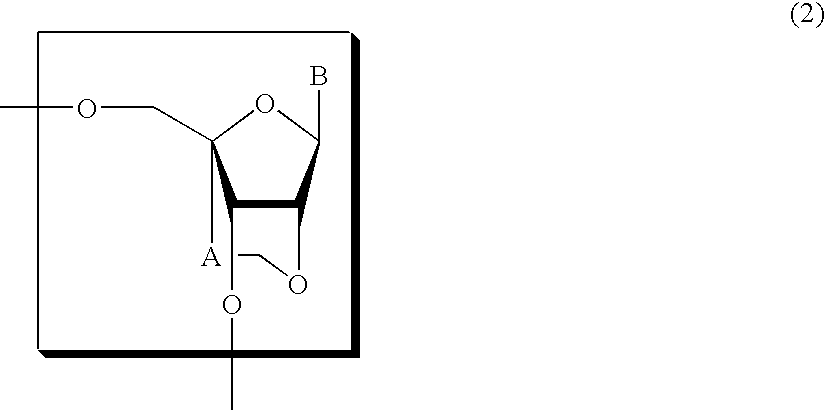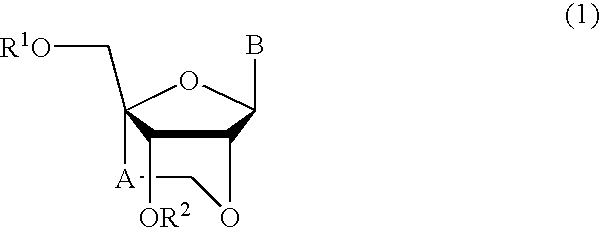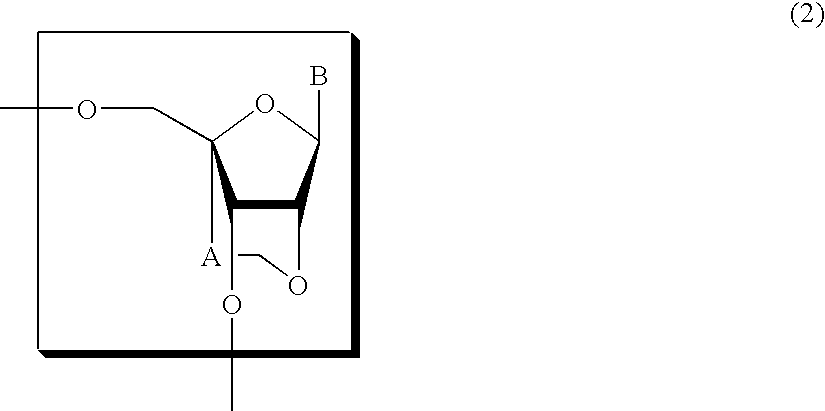Nucleoside and oligonucleotide analogues
a technology of oligonucleotide and analogues, which is applied in the field of new oligonucleotide analogues, can solve the problems that natural-occurring oligonucleotides may not have sufficient sensitivity for use as detection agents for specific genes or primers, and achieve excellent antisense or antigen activity, low incidence of adverse side effects, and excellent stability in the body
- Summary
- Abstract
- Description
- Claims
- Application Information
AI Technical Summary
Benefits of technology
Problems solved by technology
Method used
Image
Examples
example 1
3′,5′-di-O-Benzyl-2′-O,4′-C-ethylene4-N-benzoylcytidine
(Exemplification Compound Number 2-34)
[0332]An aqueous 2N sodium hydroxide solution (68 ml) was added to a solution of the compound obtained in Reference example 11 (6.80 g, 8.86 mmol) in pyridine (136 ml) at 0° C. and the mixture was stirred at room temperature for 1 hour. The reaction mixture was neutralized by dropwise addition of aqueous 20% acetic acid and extracted with chloroform. The chloroform layer was washed with saturated aqueous sodium chloride solution and concentrated in vacuo. The residue was purified by chromatography on a silica gel column (using dichloromethane:methanol=100: 3as the eluant) to afford the title compound (3.33 g, 6.02 mmol, 68%).
[0333]1H-NMR(400 MHz, CDCl3): 8.64(2H, brs), 7.89(2H, d, 7.6 Hz), 7.64-7.60(1H, m), 7.54-7.51(2H, m), 7.48-7.37(3H, m), 7.36-7.26(8H, m), 6.18(1H, s), 4.70(1H, d, 11 Hz), 4.60(1H, d, 11 Hz), 4.55(1H, d, 11 Hz), 4.46(1H, d, 2.9 Hz), 4.42(1H, d, 11 Hz), 4.10-4.02(2H,m), 3....
example 2
2′-O,4′-C-ethylene-4-N-benzoylcytidine
(Exemplification Compound Number 2-225)
[0335]A solution (31.7 ml) of 1.0 M trichloroborane in dichloromethane was added dropwise to a solution of the compound obtained in Example 1 (2.06 g, 3.72 mmol) in anhydrous methylenechloride (317 ml) at −78° C. and the mixture was stirred at −78° C. for 1 hour. The reaction mixture was slowly warmed to −20° C. and the reaction vessel was placed into an ice-sodium chloride bath and the mixture was stirred at between −20° C. and −10° C. for 2 hours. Methanol (12 ml) was slowly added to the mixture and the mixture was stirred for 10 minutes. The pH of the reaction mixture was adjust to 7-8 by dropwise addition of saturated aqueous sodium hydrogencarbonate solution. The mixture was warmed to room temperature and concentrated in vacuo. The residue was purified by chromatography on a silica gel column (using dichloromethane: methanol=100: 5 as the eluant) to afford the title compound (1.21 g, 3.24 mmol, 87%) as...
example 3
(Exemplification Compound Number 2-3)
[0338]A solution of the compound obtained in Example 2 (0.1 g, 0.268 mmol) in methanol saturated with ammonia (12 ml) was allowed to stand overnight. The mixture was concentrated to dryness to afford the title compound (0.054 g, 75%) as a white solid.
[0339]1H-NMR(500 MHz, DMSO-d6): 8.18(1H, d, 7.4 Hz), 7.10(2H, br), 5.84(1H, s), 5.69(1H, d, 7.6 Hz), 5.27-5.24(2H, m), 3.86(1H, d, 3.2 Hz), 3.90-3.78(2H, m), 3.76(1H, d, 3.2 Hz), 3.56(1H, dd, 5.5 and 12 Hz), 3.49(1H, dd, 5.5 and 12 Hz), 2.01-1.93(1H,dt, 7.5 and 12 Hz), 1.22(1H, dd, 3.6 and 13 Hz).
[0340]FAB-MAS(mNBA):270(M+H)+
PUM
 Login to View More
Login to View More Abstract
Description
Claims
Application Information
 Login to View More
Login to View More - R&D
- Intellectual Property
- Life Sciences
- Materials
- Tech Scout
- Unparalleled Data Quality
- Higher Quality Content
- 60% Fewer Hallucinations
Browse by: Latest US Patents, China's latest patents, Technical Efficacy Thesaurus, Application Domain, Technology Topic, Popular Technical Reports.
© 2025 PatSnap. All rights reserved.Legal|Privacy policy|Modern Slavery Act Transparency Statement|Sitemap|About US| Contact US: help@patsnap.com



